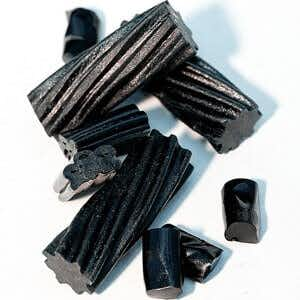
Licorice has been around for thousands of years. The plant (Glycyrrhiza glabra) from which it is derived was found in the tombs of Egyptian pharaohs and was treasured by healers in the ancient Middle East. The father of modern medicine, Hippocrates, considered licorice root a valuable healing herb. Many people today, however, encounter it as the flavoring for black licorice candy.
Is Licorice Candy or Medicine?
Although modern day herbalists still use licorice for digestive upset, coughs and arthritis, most people think of it as flavoring for candy. Many confectioners use less expensive artificial flavors or anise, but true aficionados demand the real thing. High-quality black licorice, often from Europe, contains the active ingredient glycyrrhizin.
The Dark Side of Black Licorice:
There is a dark side to licorice, though. When candy containing real licorice extract is consumed regularly or in large quantities, there can be profound metabolic consequences.
Fluid and sodium are retained, blood pressure goes up and potassium may drop to dangerously low levels. Hormonal changes can occur and may lead to weakness and in extreme cases temporary paralysis.
The Swedish Gym Teacher:
We were impressed years ago with the story of a 22-year-old Swedish gym teacher. She had been healthy, but then developed horrific headaches every month and lost her periods. She also had frighteningly high blood pressure, around 240/130. Against all of that, her primary complaint of loss of libido must have seemed insignificant.
It turned out that she had been gobbling down large quantities of black licorice. Once she stopped, all of her symptoms gradually disappeared.
The Case of the Black Jelly Beans:
In a recent case report, a 51-year old man went to the emergency department with a stomach ache that had lasted three days (Foster et al, Postgraduate Medicine, April 2017). He also reported vomiting, diarrhea and dry mouth. The workup showed alarmingly low potassium levels and blood pressure of 174/62. The doctors were puzzled since several days of treatment did not correct these problems.
They worked him up to see if his body was making too much aldosterone. Someone discovered that he’d been eating a bag of black licorice jelly beans every day, even in the hospital. On medical advice, he stopped eating the jelly beans and started taking the amiloride and spironolactone potassium-sparing blood pressure pills he had been prescribed. A few days later, blood work showed his potassium was now too high, and his blood pressure was 120/86.
The doctors discontinued the blood pressure medicine. Follow-up at ten weeks (no black licorice jelly beans) showed all his lab values were normal.
The investigators conclude:
“Prompt identification and effective management of licorice-induced hypertension may spare patients from lifelong medical therapy and prevent serious complications.”
Licorice as Medicine:
One reader recently reported her own experience, which did not involve bingeing on candy:
“A week ago at the direction of a health care professional I took a prescribed antifungal to treat Candida. I saw the ‘Licorice Root’ listed on the label and remembered hearing many years ago that licorice could raise blood pressure, but I figured a health care professional would take that into consideration. By midday, though, I was hit with a bad headache and when I took my BP it was 180/100. That scared the heck out of me. Since then it’s been as high as 190/102, which scares me even more.
“My regular doctor had just reduced the dose of my BP med because I had lost weight and my reading had been 120/68. Trying to combat this sudden spike in pressure and the unrelenting headaches, I increased the dose of my blood pressure medicine again, but it did not help. How long does it take for the effects of licorice to leave the body? I have not taken any for a week, but my pressure is still higher than it should be.”
Based on the report of the Swedish gymnastics teacher, blood pressure should return to normal within two weeks.
Some natural remedies contain licorice root. Just as with candy, this can pose a risk for susceptible people.
What About DGL?
One form of licorice is substantially safer. DGL (deglycyrrhizinated licorice) has most of the glycyrrhizin removed. This makes it less likely to raise blood pressure or cause hormone disruption. DGL is often used to treat heartburn, ulcers, canker sores and other digestive distress.
When it comes to licorice, whether it is candy or medicine, moderation is advisable. Before taking anything containing glycyrrhizin or licorice root, ask about the potential for side effects and what to do if they occur.
If you have had side effects from licorice, you can share them in the comments below.
Revised 6/26/2017

